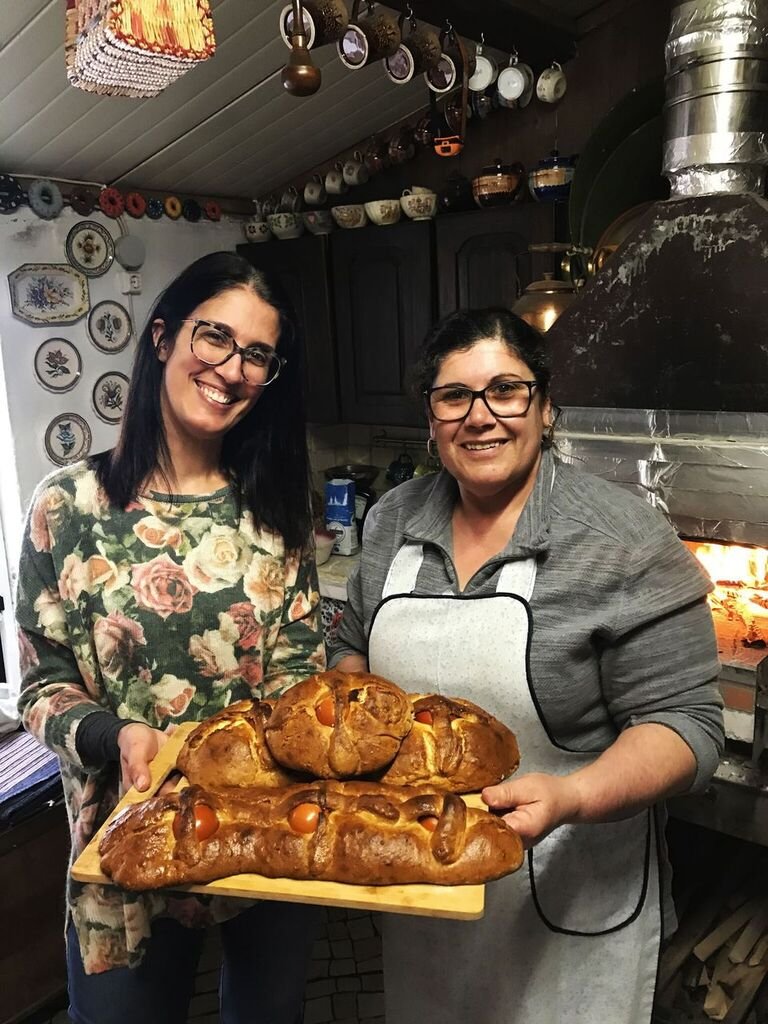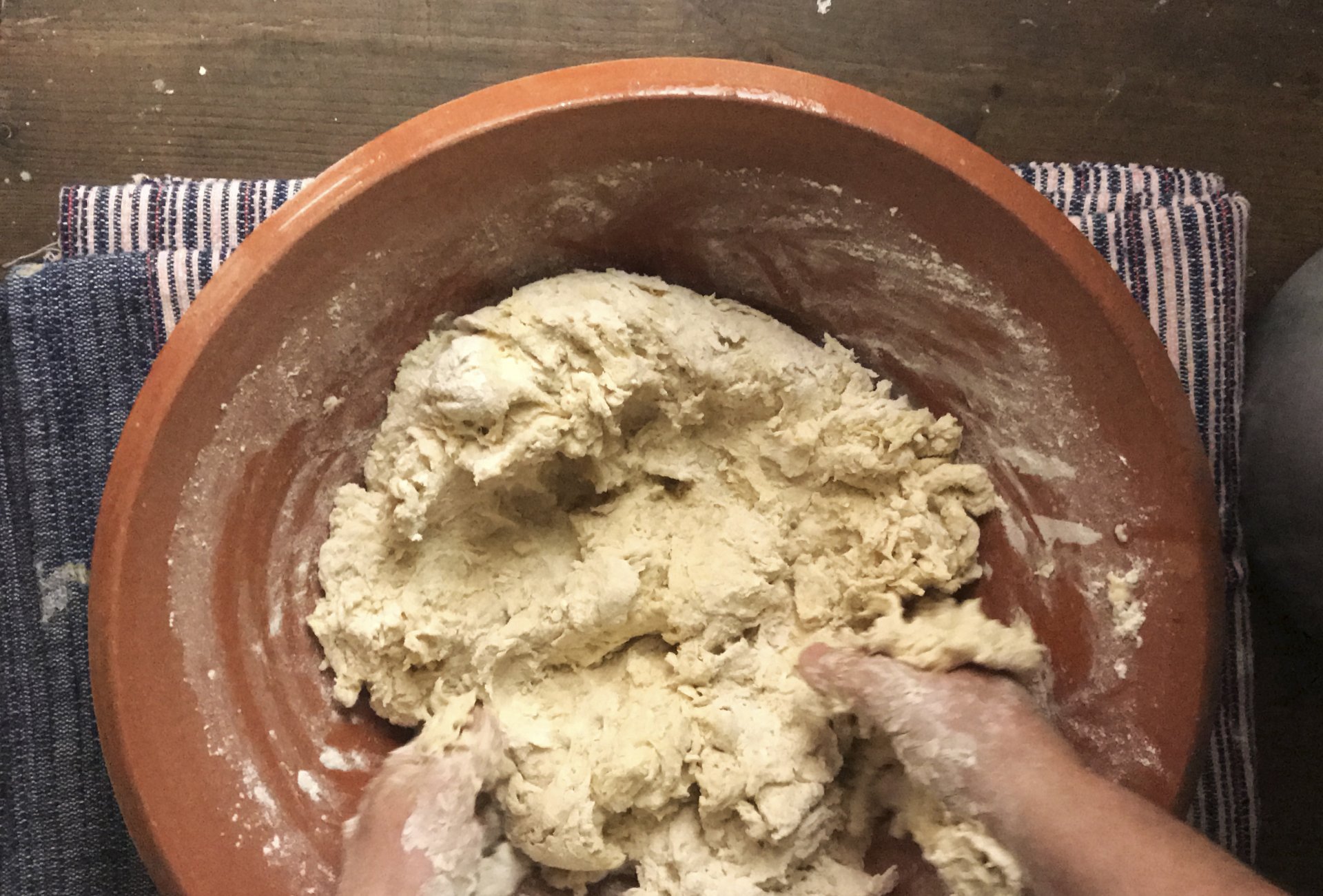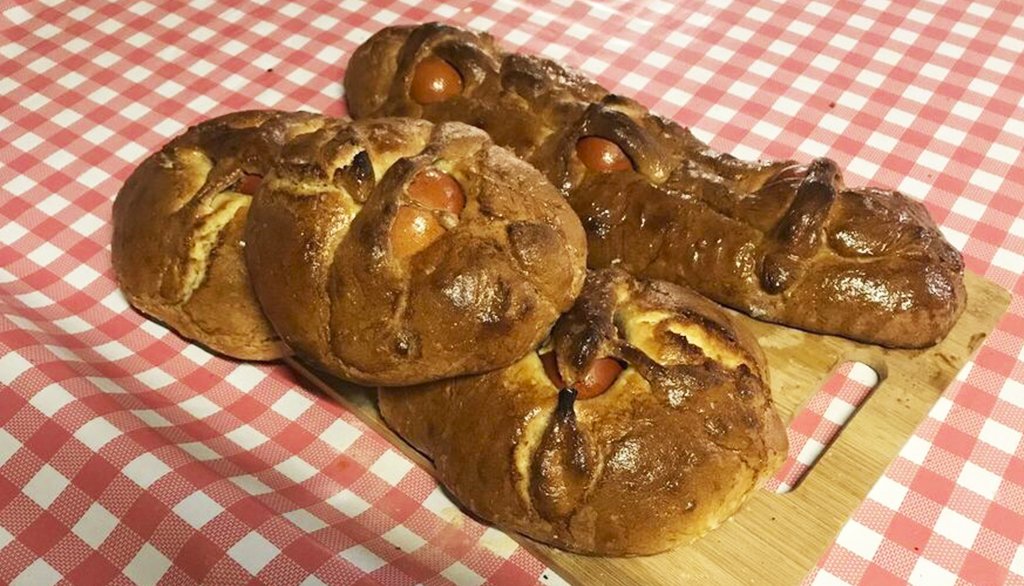



Folar in Ti’Augusta style
09 of April of 2020
We are in the week leading up to the biggest celebration related to Christianity, Easter. With this festival, traditions are approaching. This year, due to the adversities we are going through, we decided to take one of the traditions to the table.
In honor of all those we would like to have with us, we share a recipe for the most traditional cake of this time: “Folar” in the style of Tia Augusta.
“Folar” is one of the oldest and most deeply rooted traditions in our country. It is related to a legend passed down from generation to generation until today. Legend has it that this is a cake linked to union and fraternization. It celebrates friendship and reconciliation through sharing with family and friends at the table.
The origin of this dough is much more than a mere recipe. It was born from the creation of a cake with the ingredients that had in hand. It is not considered a “rich dough”, as this recipe does not include eggs, milk or fats. It as an humble origin with a rich flavor.
We present the Ti ’Augusta recipe, today represented by his daughter Gracinda. Ti'Augusta's “Folar” is a family recipe that has been passed down from generation to generation. Ti'Augusta was a small cake trader at typical village festivals. Born in the Marinheiros area, Leiria, her legacy is still appreciated today. A person very dedicated to making various delicacies. This time of year was no exception. At Easter she always prepared the folares to offer to anyone who entered. It was a time of union and gratitude. It is a centenary “folar” recipe, of a soft and sweet dough, with a soft beam of cinnamon and aromatic herbs, which today, through her daughter Gracinda, we teach how to make. Whether wood or electric, this recipe is valid for all ovens.
Ingredients (+/- 8 Folares)
- 2 Kg of Flour (type 55)
- 800 Gr of White Sugar
- 80 Gr of Baker's Yeast
- 1 Pinch of Salt
- Zest of 3 Lemons
- Cinnamon
- Fennel
- Olive oil
- 8 Eggs
- 5 glasses of warm water
First step:
- Cook the eggs with onion skin and keep. We advise you to cook the eggs one day before so that they are cold / consistent to be put in the dough.
Dough preparation:
- In a bowl, add the flour, sugar, yeast, lemon zest and salt.
- Put the cinnamon and fennel to taste and mix everything very well.
- Then separate the mixture and make a hole in the middle to put the warm water. The water will make the dough connect all the ingredients. This is the moment when you have to get your hands dirty.
- The water should be added little by little until you get a good mixture, traditionally called “erase the flour”.
- Knead very well.
- When the dough starts to make bellows it means it is on point.
- After the dough is ready, sprinkle the dough with flour.
- According to Ti’Augusta, draw a cross in the dough repeating the following saying “God add that you’ll be eaten by good people.”
- Finally, cover the container with a cloth and a warm blanket and let the dough rest for about 30 minutes.
Preparation of “Folares”:
- Sprinkle the countertop before tending the dough.
- Divide the dough into 8 pieces.
- Put the dough on the counter and place 1 egg in the middle of each piece.
- Decorate the folar with thin strips made of the cross-shaped dough over the eggs.
- Sprinkle the baking tray with flour.
- Place each folar on the trays.
- If you have an electric oven, put it for approximately 40 minutes at 180 degrees.
- If you have a wood oven, put it for approximately 20 minutes.
- As soon as you remove it from the oven, let it cool and oil each folar.
- Eat in moderation and fell the taste this inspiration.
May this Easter be a day of union and friendship, and also of sharing.
This can be done in the most diverse ways, we suggest love by sharing knowledge and flavor.
This tradition of offering “folar” during Easter also extends to family members and people we care about. It is a gesture of gratitude and love still present today between godparents and godchildren in this festive season.
It's time to get your hands dirty. If you have any questions, we have prepared a video on how to make this delicacy. See here.
If you want someone to do it, share this recipe and take our traditions further.
By Traditions,
The Inspirations team
Folar in Ti’Augusta style
09 of April of 2020




We are in the week leading up to the biggest celebration related to Christianity, Easter. With this festival, traditions are approaching. This year, due to the adversities we are going through, we decided to take one of the traditions to the table.
In honor of all those we would like to have with us, we share a recipe for the most traditional cake of this time: “Folar” in the style of Tia Augusta.
“Folar” is one of the oldest and most deeply rooted traditions in our country. It is related to a legend passed down from generation to generation until today. Legend has it that this is a cake linked to union and fraternization. It celebrates friendship and reconciliation through sharing with family and friends at the table.
The origin of this dough is much more than a mere recipe. It was born from the creation of a cake with the ingredients that had in hand. It is not considered a “rich dough”, as this recipe does not include eggs, milk or fats. It as an humble origin with a rich flavor.
We present the Ti ’Augusta recipe, today represented by his daughter Gracinda. Ti'Augusta's “Folar” is a family recipe that has been passed down from generation to generation. Ti'Augusta was a small cake trader at typical village festivals. Born in the Marinheiros area, Leiria, her legacy is still appreciated today. A person very dedicated to making various delicacies. This time of year was no exception. At Easter she always prepared the folares to offer to anyone who entered. It was a time of union and gratitude. It is a centenary “folar” recipe, of a soft and sweet dough, with a soft beam of cinnamon and aromatic herbs, which today, through her daughter Gracinda, we teach how to make. Whether wood or electric, this recipe is valid for all ovens.
Ingredients (+/- 8 Folares)
- 2 Kg of Flour (type 55)
- 800 Gr of White Sugar
- 80 Gr of Baker's Yeast
- 1 Pinch of Salt
- Zest of 3 Lemons
- Cinnamon
- Fennel
- Olive oil
- 8 Eggs
- 5 glasses of warm water
First step:
- Cook the eggs with onion skin and keep. We advise you to cook the eggs one day before so that they are cold / consistent to be put in the dough.
Dough preparation:
- In a bowl, add the flour, sugar, yeast, lemon zest and salt.
- Put the cinnamon and fennel to taste and mix everything very well.
- Then separate the mixture and make a hole in the middle to put the warm water. The water will make the dough connect all the ingredients. This is the moment when you have to get your hands dirty.
- The water should be added little by little until you get a good mixture, traditionally called “erase the flour”.
- Knead very well.
- When the dough starts to make bellows it means it is on point.
- After the dough is ready, sprinkle the dough with flour.
- According to Ti’Augusta, draw a cross in the dough repeating the following saying “God add that you’ll be eaten by good people.”
- Finally, cover the container with a cloth and a warm blanket and let the dough rest for about 30 minutes.
Preparation of “Folares”:
- Sprinkle the countertop before tending the dough.
- Divide the dough into 8 pieces.
- Put the dough on the counter and place 1 egg in the middle of each piece.
- Decorate the folar with thin strips made of the cross-shaped dough over the eggs.
- Sprinkle the baking tray with flour.
- Place each folar on the trays.
- If you have an electric oven, put it for approximately 40 minutes at 180 degrees.
- If you have a wood oven, put it for approximately 20 minutes.
- As soon as you remove it from the oven, let it cool and oil each folar.
- Eat in moderation and fell the taste this inspiration.
May this Easter be a day of union and friendship, and also of sharing.
This can be done in the most diverse ways, we suggest love by sharing knowledge and flavor.
This tradition of offering “folar” during Easter also extends to family members and people we care about. It is a gesture of gratitude and love still present today between godparents and godchildren in this festive season.
It's time to get your hands dirty. If you have any questions, we have prepared a video on how to make this delicacy. See here.
If you want someone to do it, share this recipe and take our traditions further.
By Traditions,
The Inspirations team
